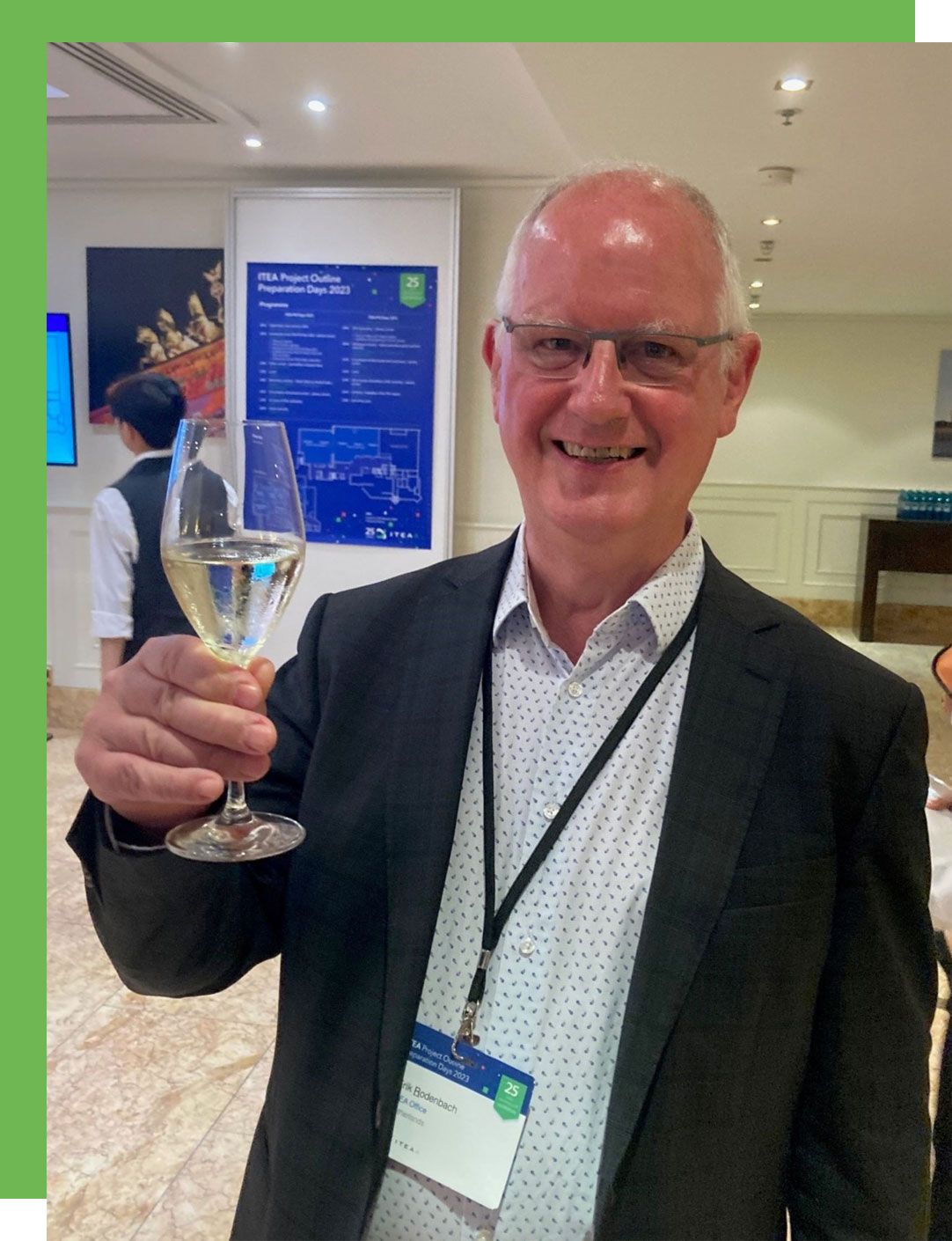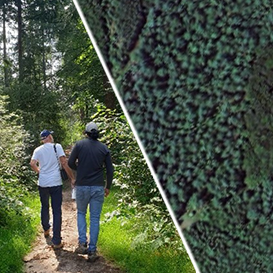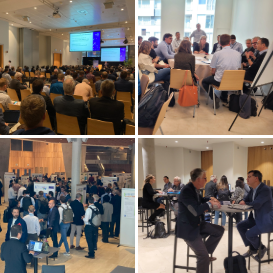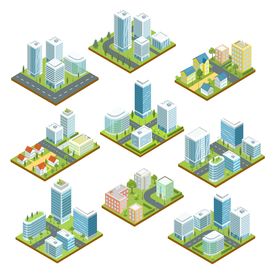Erik Rodenbach
Running a well-oiled machine
Having started his career as an electronic engineer in the early 1980s, Erik Rodenbach describes himself as “one of the lucky young guys to be turned into a software engineer.” This set him on the path to ITEA, where he would spend almost 24 years as the Programme Coordinator. Following his departure this year, Erik looks back on the changes in ITEA and the positive influence this brought.

A recommended replacement
Like ITEA, Erik’s career has always been evolving. Initial work in R&D at Philips gave way to a position at Schlumberger on the automation of fuel stations. There, he first started to take on managerial tasks and also came into contact with public funding through national and EU R&D projects.
“At the end of the 90s, I was around 45. That’s the age when you get a bit of a midlife crisis, I suppose,” Erik laughs. “I’d been working all that time for big companies but that’s not really my ambition. So, I started an evening course in business administration just to prepare myself to start my own company.” This was to be ERaQua, an innovation and quality consultancy firm. It was in this context that Erik was introduced to ITEA: a former colleague was serving as the Programme Coordinator and recommended Erik as his replacement. At the start, he devoted roughly 50% of ERaQua’s activities to ITEA, but this gradually increased to 80% over the years.
Making more noise
“In those early days, it was a really small team,” says Erik. “But I liked it; the atmosphere was very good. We always had a strong willingness to cooperate, and it was an exciting time because the Office was just like a small startup. The team I started with was completely different to the one in my last years, but that same atmosphere was always there.” One of the first points of attention was the PO Days, the annual event in which the ITEA Community comes together to build up new projects. Erik joined ITEA during its fourth Call but was surprised to find only ten people at his first PO Days.
“One of the things I decided to change – with the support of the Chairman and Vice-chairman – was that we promoted the ITEA PO Days to a larger audience. The next year, we had a small area in a hotel in Brussels and we expected maybe 50 people. Suddenly, 100 showed up! The room was packed, but the atmosphere was fantastic. People were very enthusiastic and creative, eager to share their ideas. That was a great moment for me.”
The new PO Days
It’s been about contact with so many people who are so enthusiastic.
In addition to a higher turnout, that event saw the introduction of companies from beyond the founding members of ITEA, as well as more SMEs and a wider range of nationalities. Erik and the team would subsequently build on this success with a new format for the PO Days. “First, we created a marketplace where people could share posters and connect. Then, we allowed them to make five-minute pitches. Finally, we asked them to collaborate throughout the day and come back to us at the end to share what they had achieved. You didn’t need to guide people much. Once you provided the structure, they were motivated and creative enough to drive the process themselves. The PO Days are much more professional now but, over the years, the format has served as the basis for a successful event.”
“The most recent PO Days had around 300 participants. I think this is the maximum you should have. I’ve been to EU events with thousands of attendees, and you feel lost in those massive crowds. But with a smaller group, the atmosphere is more creative. About 70% of submitted project proposals were first presented at the PO Days, which is a testament to the success of the format.”
Starting a trend
Today, this Community is ITEA’s key asset, providing a well-rounded ecosystem that fosters collaboration between large companies, SMEs, universities and research institutions. However, Erik remembers a time before this was the norm: in the early 2000s, the big automotive OEMs all had their dedicated electronic units and suppliers had to deal with many variants and interfaces. This all changed with the ITEA project East-EEA, in which OEMs and suppliers defined a common language to standardise the interaction with the increasing number of electronic components in cars. Standardisation became essential and later projects continued to develop this. Many functionalities in modern cars are based on these very standards.
This is far from the only seismic shift that Erik has witnessed. 20 years ago, he first saw a demonstration on using a smartphone to make purchases. Nowadays, this technology is taken for granted. Even the current sensation around artificial intelligence has some of its roots in ITEA, which ran early Internet of Things projects that paved the way to the enormous amounts of data needed for AI. “It was fascinating to witness trends emerge at an early stage, when nobody had heard of them, and see them become commonplace,” Erik smiles. “ITEA projects are important within the whole innovation landscape because they are already quite close to the market. We provide a playground to use emerging technologies, allowing engineers to see how they can work in real life.”
The human element
Still, when reflecting on the personal meaning that his role brought to him, Erik’s mind goes not to a technological innovation but to a human connection. “In the early 2000s, we needed somebody to help us create an IT system. This wasn’t a university graduate but a young student from a technical school. His teacher approached me and said he wasn’t performing very well. But the young man was exceptionally fast and capable, quickly setting things up and developing tools we could use. After some time, his teacher came back and said he was astonished about the change he saw. And without the IT system he started, we wouldn’t be able to work as efficiently as we do today.”
“In terms of my happiness, it’s been about contact with so many people who are so enthusiastic. For instance, there was the Steering Group, a group of technical experts of the founding companies supporting ITEA, which became a real group of friends. But I really enjoyed simply working with the Office team and I learned a lot from my time in ITEA. We worked very hard together, not just on our own tasks but also on each other’s when needed. We constantly improved ourselves. A new Office Director once said, ‘I see the Office as a well-oiled machine.’ He was right! And I was happy to be part of that.”
Other chapters
Use the arrows to view more chapters

Editorial
By Dirk Elias and Régis Cazenave

Country Focus: Canada
Ten years of successful collaborations through ITEA

Kelvin Zero
Taking health data out of silos with Secur-e-Health

ITEA Success story: OPTIMUM
Offering greater efficiency, safety and usability in future smart factories

Community Talk with Erik Rodenbach
Running a well-oiled machine

SME in the Spotlight: D-SIMLAB
Simulation support for semicon and aerospace

End user happiness: Deep4Sat43
Satellite technology enhancing forest health

ITEA PO Days 2024 and exhibition
Active ITEA Community delivers a record number of ideas

ITEA Success story: BIMy
An innovation engine for integrated BIM and GIS

